Effects of Pet Insects on Cognitive Function among the Elderly: An fMRI Study
Abstract
1. Introduction
2. Methods
2.1. Subject Eligibility
2.2. Screening
2.3. Sample Size, Randomization and Study Procedure
2.4. fMRI (Functional Magnetic Resonance Imaging)
2.5. Paradigm for the Testing of Working Memory Processing: Wisconsin Card Sorting Test (WCST)
2.6. Image Analysis
2.7. Stastical Analysis
3. Results
3.1. Baseline Characteristics of the Subjects
3.2. WCST Response Data Results
3.3. fMRI Data Analysis Results
4. Discussion
Author Contributions
Funding
Conflicts of Interest
References
- Statistics Korea. Statistics Report about the Elderly. 2018. Available online: http://kostat.go.kr (accessed on 20 December 2018).
- Bernabei, V.; De Ronchi, D.; La Ferla, T.; Moretti, F.; Tonelli, L.; Ferrari, B.; Forlani, M.; Atti, A.R. Animal-assisted interventions for elderly patients affected by dementia or psychiatric disorders: A review. J. Psychiatr. Res. 2013, 47, 762–773. [Google Scholar] [CrossRef]
- Cherniack, E.P.; Cherniack, R.A. The benefit of pets and animal-assisted therapy to the health of older individuals. Curr. Gerontol. Geriatr. Res. 2014, 2014. [Google Scholar] [CrossRef]
- Harris, M.D.; Rinehart, J.M.; Gerstman, J. Animal-assisted therapy for the homebound elderly. Holist. Nurs. Pract. 1993, 8, 27–37. [Google Scholar] [CrossRef]
- Moretti, F.; De Ronchi, D.; Bernabei, V.; Marchetti, L.; Ferrari, B.; Forlani, C.; Negretti, F.; Sacchetti, C.; Atti, A.R. Pet therapy in elderly patients with mental illness. Psychogeriatrics 2011, 11, 125–129. [Google Scholar] [CrossRef]
- Richeson, N.E. Effects of animal-assisted therapy on agitated behaviors and social interactions of older adults with dementia. Am. J. Alzheimers Dis. Other Demen. 2003, 18, 353–358. [Google Scholar] [CrossRef]
- Zisselman, M.H.; Rovner, B.W.; Shmuely, Y.; Ferrie, P. A pet therapy intervention with geriatric psychiatry inpatients. Am. J. Occup. Ther. 1996, 50, 47–51. [Google Scholar] [CrossRef]
- Ministry of Education and Science Technology. Elementary School Guideline for Teachers (Science), 7th ed.; Ministry of Education and Science Technology: Kumsung, Korea, 2011; pp. 1–386. [Google Scholar]
- Ko, H.J.; Youn, C.H.; Kim, S.H.; Kim, S.Y. Effect of Pet Insects on the Psychological Health of Community-Dwelling Elderly People: A Single-Blinded, Randomized, Controlled Trial. Gerontology 2016, 62, 200–209. [Google Scholar] [CrossRef]
- Bandettini, P.A.; Wong, E.C.; Hinks, R.S.; Tikofsky, R.S.; Hyde, J.S. Time course EPI of human brain function during task activation. Magn. Reson. Med. 1992, 25, 390–397. [Google Scholar] [CrossRef] [PubMed]
- Ogawa, S.; Tank, D.W.; Menon, R.; Ellermann, J.M.; Kim, S.G.; Merkle, H.; Ugurbil, K. Intrinsic signal changes accompanying sensory stimulation: Functional brain mapping with magnetic resonance imaging. Proc. Natl. Acad. Sci. USA 1992, 89, 5951–5955. [Google Scholar] [CrossRef] [PubMed]
- Kesler, S.R.; Haberecht, M.F.; Menon, V.; Warsofsky, I.S.; Dyer-Friedman, J.; Neely, E.K.; Reiss, A.L. Functional neuroanatomy of spatial orientation processing in Turner syndrome. Cereb. Cortex 2004, 14, 174–180. [Google Scholar] [CrossRef] [PubMed]
- Seo, J.; Kim, Y.T.; Song, H.J.; Lee, H.J.; Lee, J.; Jung, T.D.; Lee, G.; Kwon, E.; Kim, J.G.; Chang, Y. Stronger activation and deactivation in archery experts for differential cognitive strategy in visuospatial working memory processing. Behav. Brain Res. 2012, 229, 185–193. [Google Scholar] [CrossRef] [PubMed]
- Stone, M.; Gabrieli, J.D.; Stebbins, G.T.; Sullivan, E.V. Working and strategic memory deficits in schizophrenia. Neuropsychology 1998, 12, 278–288. [Google Scholar] [CrossRef] [PubMed]
- Le Bihan, D.; Karni, A. Applications of magnetic resonance imaging to the study of human brain function. Curr. Opin. Neurobiol. 1995, 5, 231–237. [Google Scholar] [CrossRef]
- Kang, Y.; Na, D.L.; Hahn, S. A validity study on the korean mini-mental state examination (K-MMSE) in dementia patients. J. Korean Neurol. Assoc. 1997, 15, 300–308. [Google Scholar]
- Desmond, J.E.; Glover, G.H. Estimating sample size in functional MRI (fMRI) neuroimaging studies: Statistical power analyses. J. Neurosci. Methods 2002, 118, 115–128. [Google Scholar] [CrossRef]
- Kim, S.Y.; Kim, S.H.; Jung, J.C.; Lee, K.P.; Kim, N.J. Effects of experience-based learning program using singing insects. J. Seric. Entomol. Sci. 2013, 51, 114–118. [Google Scholar]
- Kim, N.J.; Hong, S.J.; Seol, K.Y.; Kim, S.H.; Ahn, N.H.; Kim, M. Effect of temperature on development and reproduction of the emma field cricket, Teleogryllus Emma (Orthoptera: Gryllidae). Int. J. Ind. Entomol. 2007, 15, 69–73. [Google Scholar]
- Nyhus, E.; Barceló, F. The Wisconsin Card Sorting Test and the cognitive assessment of prefrontal executive functions: A critical update. Brain Cogn. 2009, 71, 437–451. [Google Scholar] [CrossRef]
- Yun-Hee, K. Usefulness of Functional MRI for the Study of Brain Function. Korean J. Brain Sci. Technol. 2001, 1, 65–76. [Google Scholar]
- Fletcher, P.C.; Henson, R.N.A. Frontal lobes and human memory: Insights from functional neuroimaging. Brain 2001, 124, 849–881. [Google Scholar] [CrossRef]
- Yuan, P.; Raz, N. Prefrontal cortex and executive functions in healthy adults: A meta-analysis of structural neuroimaging studies. Neurosci. Biobehav. Rev. 2014, 42, 180–192. [Google Scholar] [CrossRef] [PubMed]
- Stuss, D.T.; Levine, B.; Alexander, M.P.; Hong, J.; Palumbo, C.; Hamer, L.; Murphy, K.J.; Izukawa, D. Wisconsin Card Sorting Test performance in patients with focal frontal and posterior brain damage: Effects of lesion location and test structure on separable cognitive processes. Neuropsychologia 2000, 38, 388–402. [Google Scholar] [CrossRef]
- D’Esposito, M.; Postle, B.R.; Rypma, B. Prefrontal Cortical Contributions to Working Memory: Evidence from Event-Related Fmri Studies; Springer: Berlin/Heidelberg, Germany, 2000. [Google Scholar]
- Hampson, M.; Driesen, N.R.; Skudlarski, P.; Gore, J.C.; Constable, R.T. Brain Connectivity Related to Working Memory Performance. J. Neurosci. 2006, 26, 13338–13343. [Google Scholar] [CrossRef] [PubMed]
- Pascual, L.F.; Fernández, T.; Saz, P.; Lobo, A.; Morales, F. The assessment of working memory by Mini-Mental State Examination. Rev. Neurol. 2000, 30, 1–4. [Google Scholar]
- Oh, E.; Kang, Y.; Shin, J.H.; Yeon, B.K. A Validity Study of K-MMSE as a Screening Test for Dementia: Comparison Against a Comprehensive Neuropsychological Evaluation. Dement. Neurocogn. Disord. 2010, 9, 8–12. [Google Scholar]
- Hoops, S.; Nazem, S.; Siderowf, A.D.; Duda, J.E.; Xie, S.X.; Stern, M.B.; Weintraub, D. Validity of the MoCA and MMSE in the detection of MCI and dementia in Parkinson disease. Neurology 2009, 73, 1738–1745. [Google Scholar] [CrossRef]
- Axelrod, B.N.; Goldman, R.S.; Henry, R.R. Sensitivity of the Mini-Mental State Examination to frontal lobe dysfunction in normal aging. J. Clin. Psychol. 1992, 48, 68–71. [Google Scholar] [CrossRef]
- Peluso, S.; De Rosa, A.; De Lucia, N.; Antenora, A.; Illario, M.; Esposito, M.; De Michele, G. Animal-Assisted Therapy in Elderly Patients: Evidence and Controversier in Dementia and Psychiatric Disorders and Future Perspectives in Other Neurological Disease. J. Geriatr. Psychiatry Neurol. 2018, 31, 149–157. [Google Scholar] [CrossRef]
- Ng, Q.X.; Ho, C.Y.X.; Koh, S.S.H.; Tan, W.C.; Chan, H.W. Doll therapy for dementia suffers: A systematic review. Complement Ther. Clin. Pract. 2017, 22, 42–46. [Google Scholar] [CrossRef]
- Ganguli, M.; Ratcliff, G.; Huff, J.; Belle, S.; Kancel, M.J.; Fischer, L.; Seaberg, E.C.; Kuller, L.H. Effects of age, gender, and education on cognitive tests in a rural elderly community sample: Norms from the Monongahela Valley Independent Elders Survey. Neuroepidemiology 1991, 10, 42–52. [Google Scholar] [CrossRef]
- Wiederholt, W.C.; Cahn, D.; Butters, N.M.; Salmon, D.P.; Kritz-Silverstein, D.; Barrett-Connor, E. Effects of age, gender and education on selected neuropsychological tests in an elderly community cohort. J. Am. Geriatr. Soc. 1993, 41, 639–647. [Google Scholar] [CrossRef] [PubMed]
- Kawamura, N.; Niiyama, M.; Niiyama, H. Long-term evaluation of animal-assisted therapy for institutionalized elderly people: A preliminary result. Psychogeriatrics 2007, 7, 8–13. [Google Scholar] [CrossRef]
- Menna, L.F.; Santaniello, A.; Gerardi, F.; Di Maggio, A.; Milan, G. Evaluation of the efficacy of animal-assisted therapy based on the reality orientation therapy protocol in Alzheimer’s disease patients: A pilot study. Psychogeriatrics 2016, 16, 240–246. [Google Scholar] [CrossRef] [PubMed]
- Chaudhary, S.; Narkeesh, A.; Gupta, N. A study of cognition in realation with hand dominance. J. Exerc. Sci. Physiother. 2009, 5, 20–23. [Google Scholar]
- Cuzzocreo, J.L.; Yassa, M.A.; Verduzco, G.; Honeycutt, N.A.; Scott, D.J.; Bassett, S.S. Effect of handness on f MRI activation in the medial temporal lobe during an auditory verbal memory task. Hum. Brain Mapp. 2009, 30, 1271–1278. [Google Scholar] [CrossRef] [PubMed]
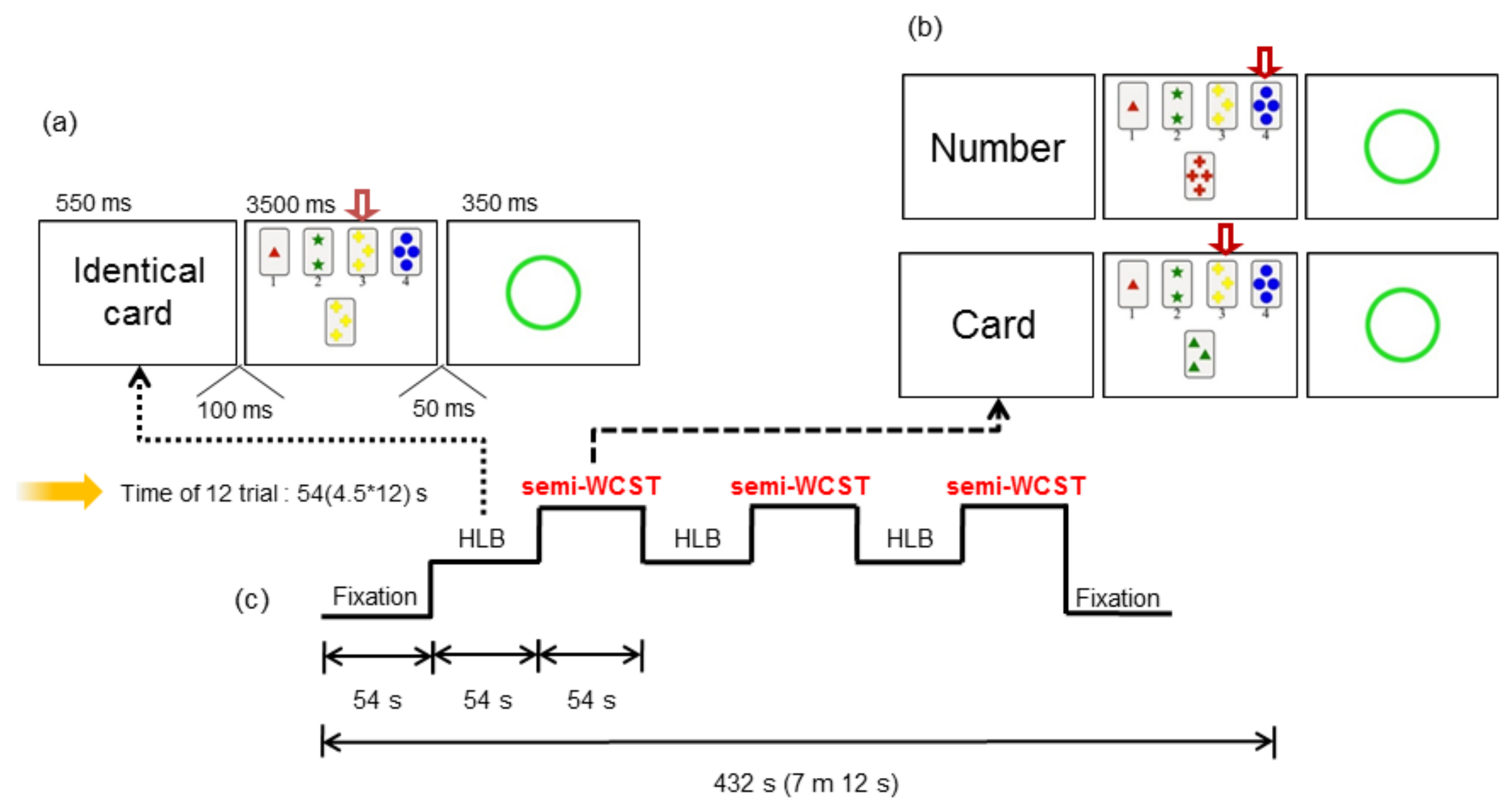
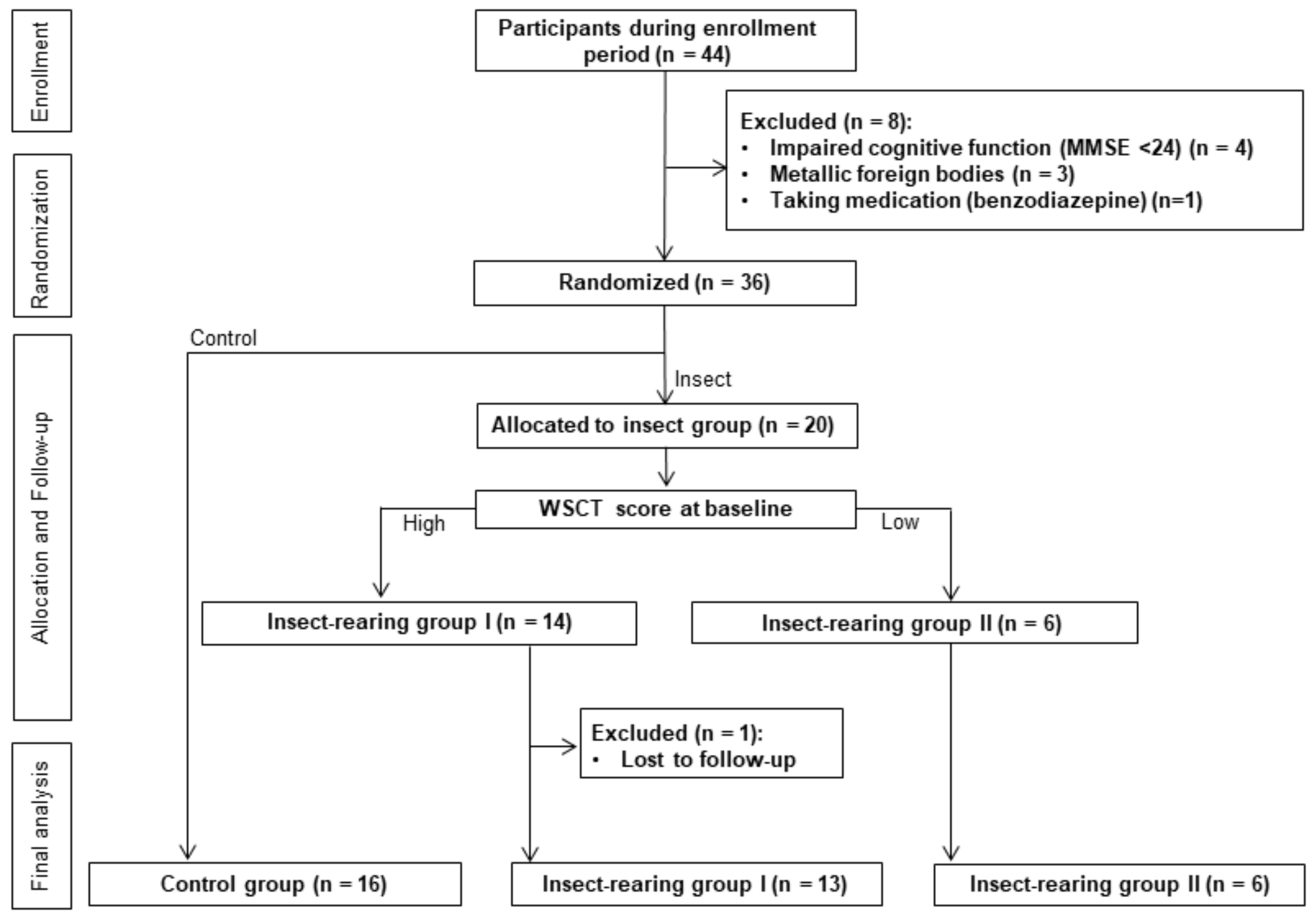
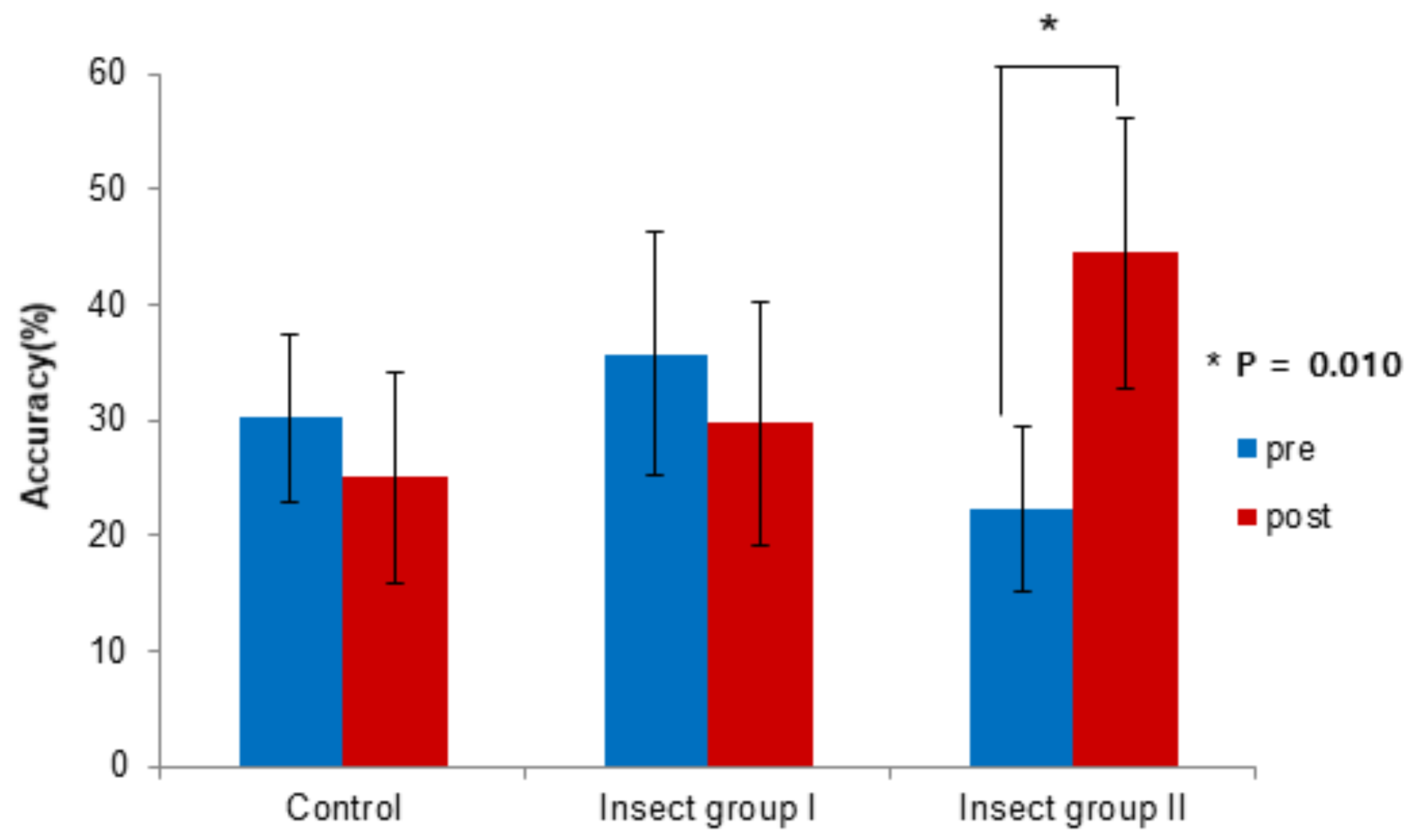
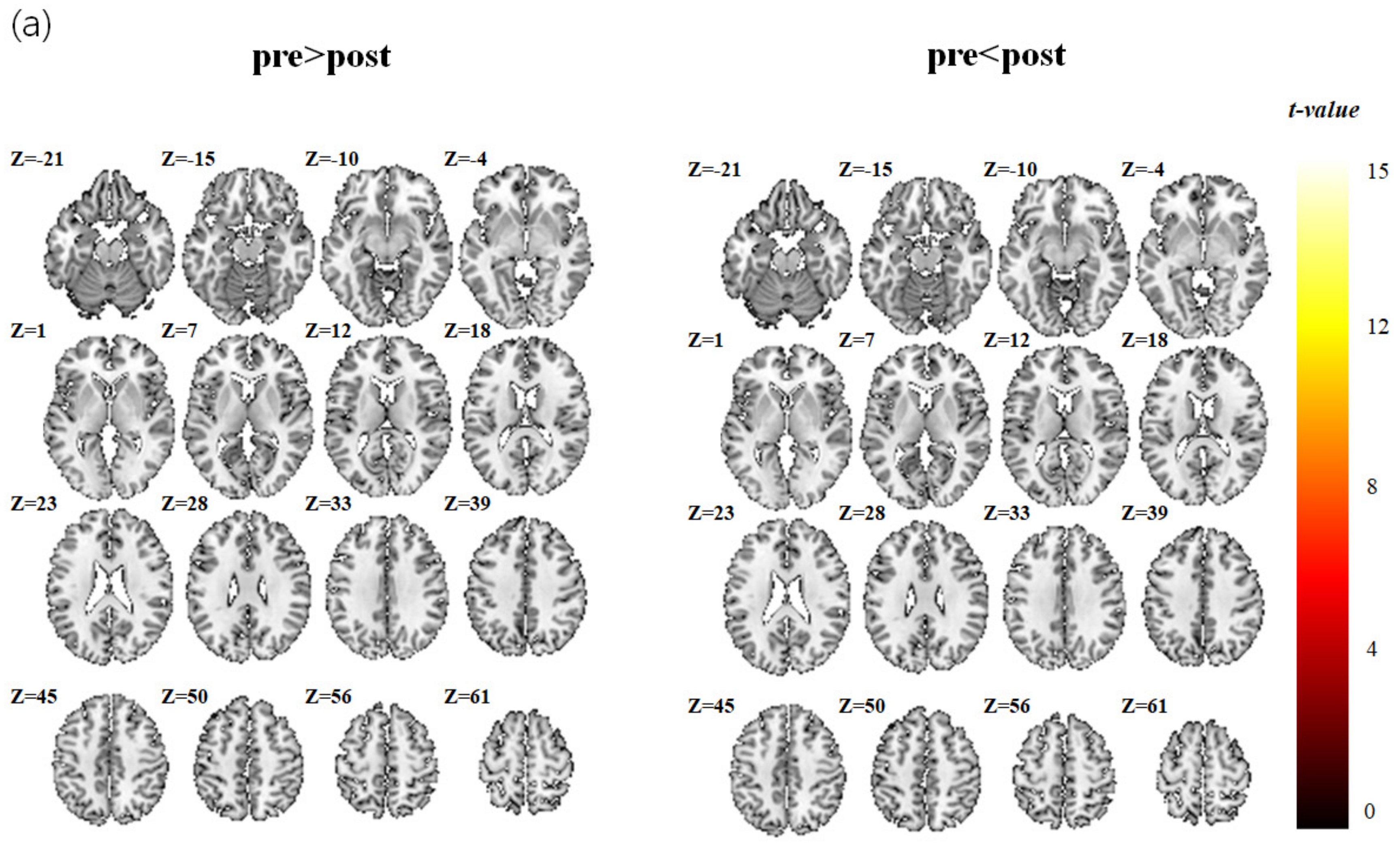
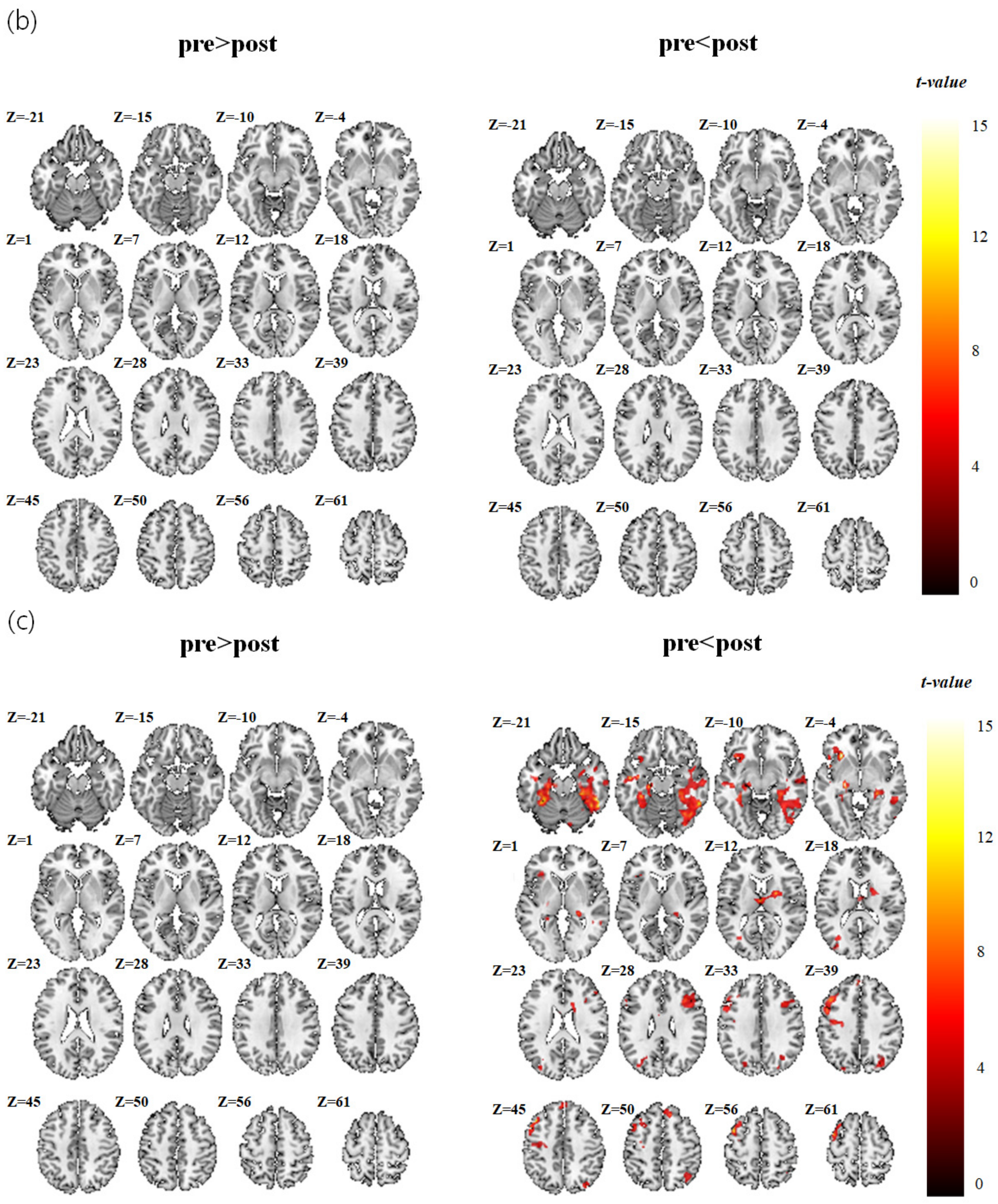
| Control Group (n = 16) | Insect-Rearing Group I (n = 13) | Insect-Rearing Group II (n = 6) | p-Value * | |
|---|---|---|---|---|
| Age, years | 66.38 ± 5.39 | 68.31 ± 3.75 | 70.67 ± 3.93 | 0.15 |
| Height, cm | 152.44 ± 5.54 | 156.16 ± 4.38 | 153.95 ± 6.57 | 0.19 |
| Weight, kg | 52.48 ± 9.10 | 65.28 ± 24.31 | 57.60 ± 3.69 | 0.12 |
| Body mass index, kg/m2 | 22.49 ± 3.26 | 26.93 ± 11.06 | 24.31 ± 0.98 | 0.26 |
| Waist circumference, cm | 80.06 ± 8.81 | 84.19 ± 11.26 | 85.17 ± 6.43 | 0.39 |
| Blood pressure, mmHg | ||||
| Systolic | 134.25 ± 19.05 | 137.46 ± 12.89 | 137.50 ± 21.30 | 0.86 |
| Diastolic | 72.31 ± 13.73 | 78.15 ± 8.95 | 71.50 ± 11.06 | 0.34 |
| Heart rate, beats/min | 70.00 ± 9.71 | 68.85 ± 7.61 | 68.83 ± 4.02 | 0.92 |
| MMSE (cognitive function) | 27.94 ± 1.98 | 27.77 ± 1.74 | 27.50 ± 1.64 | 0.88 |
| Smoking status | ||||
| Non- or ex-smoker | 15 (93.8) | 13 (100.0) | 6 (100.0) | 1.000† |
| Current smoker | 1 (6.3) | 0 (0.0) | 0 (0.0) | |
| Alcohol consumption | ||||
| None | 12 (75.0) | 12 (92.3) | 5 (83.3) | 0.613 † |
| Any | 4 (25.0) | 1 (7.7) | 1 (16.7) | |
| Exercise | ||||
| None | 15 (93.8) | 12 (92.3) | 5 (83.3) | 0.762 † |
| Regular | 1 (6.3) | 1 (7.7) | 1 (16.7) | |
| Education | ||||
| ≤Elementary school | 8 (50.0) | 8 (61.5) | 5 (83.3) | 0.125 † |
| ≥Middle school | 8 (50.0) | 5 (38.5) | 1 (16.7) | |
| Clinically diagnosed underlying disease | ||||
| Hypertension | 6 (37.5) | 7 (53.8) | 1 (16.7) | 0.317 † |
| Diabetes | 1 (6.3) | 2 (15.4) | 0 (0.0) | 0.762 † |
| Dyslipidemia | 5 (31.3) | 9 (69.2) | 2 (33.3) | 0.113 † |
| Cardiovascular disease | 0 (0.0) | 1 (7.7) | 0 (0.0) | 0.543 † |
| Control Group | Insect-Rearing Group I | Insect-Rearing Group II | p-Value † | ||
|---|---|---|---|---|---|
| Accuracy (%) | Baseline | 30.21 ± 13.64 | 35.68 ± 17.49 | 22.22 ± 6.80 | 0.180 |
| After 8 weeks | 25.00 ± 16.43 | 29.70 ± 17.36 | 44.44 ± 11.25 | 0.060 | |
| p-value * | 0.329 | 0.319 | 0.010 | ||
| Contrast | Region | Cluster Size | Coordinates (mm) | Peak T | |||
|---|---|---|---|---|---|---|---|
| x | y | z | |||||
| Semi-HLB | Middle frontal gyrus | L | 544 | −46 | 22 | 44 | 16.29 |
| Superior medial frontal gyrus | L | 97 | −2 | 48 | 40 | 8.53 | |
| Precentral gyrus | L | 79 | −42 | −10 | 36 | 5.07 | |
| Superior parietal lobule | R | −100 | 38 | −60 | 50 | 4.77 | |
| Inferior frontal gyrus | R | 158 | 38 | 16 | 34 | 5.51 | |
| Precuneus | L | 20 | −24 | −82 | 36 | 4.31 | |
| R | 110 | 28 | −80 | 38 | 4.58 | ||
| Putamen | R | 57 | 22 | 0 | 12 | 8.96 | |
| Thalamus | L | 60 | −4 | −12 | 10 | 6.88 | |
| R | 49 | 4 | −12 | 12 | 5.03 | ||
| Insula | L | 173 | −32 | 14 | −14 | 8.88 | |
| Inferior orbito-frontal gyrus | L | 147 | −36 | 20 | −14 | 5.26 | |
| Hippocampus | L | 133 | −20 | −22 | −14 | 8.88 | |
| R | 236 | 24 | −34 | −4 | 7.88 | ||
| Fusiform gyrus | L | 572 | −36 | −36 | −20 | 17.61 | |
| R | 1072 | 28 | −30 | −20 | 8.01 | ||
© 2019 by the authors. Licensee MDPI, Basel, Switzerland. This article is an open access article distributed under the terms and conditions of the Creative Commons Attribution (CC BY) license (http://creativecommons.org/licenses/by/4.0/).
Share and Cite
Park, J.-Y.; Ko, H.-J.; Kim, A.-S.; Moon, H.-N.; Choi, H.-I.; Kim, J.-H.; Chang, Y.; Kim, S.-H. Effects of Pet Insects on Cognitive Function among the Elderly: An fMRI Study. J. Clin. Med. 2019, 8, 1705. https://doi.org/10.3390/jcm8101705
Park J-Y, Ko H-J, Kim A-S, Moon H-N, Choi H-I, Kim J-H, Chang Y, Kim S-H. Effects of Pet Insects on Cognitive Function among the Elderly: An fMRI Study. Journal of Clinical Medicine. 2019; 8(10):1705. https://doi.org/10.3390/jcm8101705
Chicago/Turabian StylePark, Ji-Yeon, Hae-Jin Ko, A-Sol Kim, Ha-Na Moon, Hye-In Choi, Jin-Hee Kim, Yongmin Chang, and Seong-Hyun Kim. 2019. "Effects of Pet Insects on Cognitive Function among the Elderly: An fMRI Study" Journal of Clinical Medicine 8, no. 10: 1705. https://doi.org/10.3390/jcm8101705
APA StylePark, J.-Y., Ko, H.-J., Kim, A.-S., Moon, H.-N., Choi, H.-I., Kim, J.-H., Chang, Y., & Kim, S.-H. (2019). Effects of Pet Insects on Cognitive Function among the Elderly: An fMRI Study. Journal of Clinical Medicine, 8(10), 1705. https://doi.org/10.3390/jcm8101705





